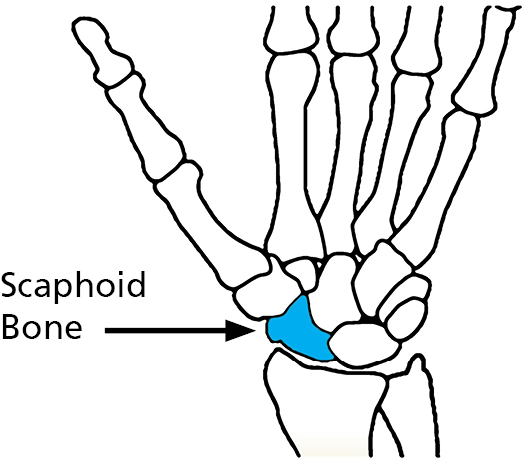Thank you for attending the Emergency Department (ED) for the treatment of your injured wrist.
The clinician who assessed your wrist suspected an injury to a bone called the scaphoid. This is a small bone in the wrist on the thumb side. It can be broken (fracture) after a fall or impact on the outstretched hand and wrist.

It is important that this fracture is diagnosed and treated promptly for the following reason:
The scaphoid bone receives its blood supply in the middle narrower part called waist. If there is a displaced fracture at this site, this can affect the blood supply and stop oxygen and nutrients reaching the bone. If this happens, it can cause complications such as slow healing (delayed union) or no healing (non-union). If the blood supply is cut off completely, part of the bone can die (avascular necrosis). These complications can cause continued pain, impairment of wrist function and early arthritis.
At your initial visit to ED, x-rays of your wrist and specific views to look at the scaphoid bone, are taken to diagnose a break (fracture). If the broken pieces have moved away from each other, a fracture line is visible on x-rays. A diagnosis of displaced fracture of scaphoid is made, and you will have further treatment.
However sometimes the broken pieces stay close to each other, and a fracture line is not visible on x-rays. This is a suspected undisplaced fracture of scaphoid. Your wrist will be treated for a suspected fracture by immobilising it in a splint until further assessment in the ED Returns Clinic.
An appointment request slip is given to you at end of your initial consultation to take to the ED reception to book an appointment for this clinic, usually a week or so later.
Instructions to patients with suspected scaphoid fracture
In the meanwhile, you are advised to:
Do
- Always keep the splint on, except when having a shower or bath
- Take painkillers as required
- Elevate the limb
- Move and exercise the joints not included in the wrist splint, such as your fingers, elbow and shoulder
Do not
- Don’t drive
- Don’t use the injured hand and wrist for manual work
- Don’t use the injured hand and wrist in sports and gym activity.
ED Returns Clinic Review
ED Returns Clinic is held on Wednesday, Thursday and Friday mornings. It is situated at A Floor, Clarendon Wing at Leeds General Infirmary. At the clinic visit, a senior ED doctor or a physiotherapist will re-examine your wrist to evaluate for fracture. If scaphoid fracture is still suspected, an MRI scan of your wrist will be arranged. The doctor/physiotherapist will go through some medical details and a check list to make sure that an MRI scan is suitable for you. It is important that you tell them if you have a pacemaker, a nerve stimulator, or any metallic object in your body. If an MRI scan is not acceptable or suitable for you, a CT scan can be arranged as an alternative.
Until the scan results have been received and discussed with you, your wrist should still be immobilised in the wrist splint.
The MRI department will contact you by phone to give you an appointment date, time and place of scan. If they are unable to get in touch with you on the phone, you will receive a letter and a text message.
You can contact MRI department on 0113 392 4616 if you have any questions about your MRI scan.
After MRI/CT scan
Please contact the ED admin team on 0113 392 6823 or 0113 392 6284 on the day your scan is done to confirm that you have had the scan. If this is not possible, please call the next working day. This allows us to obtain the report without delay.
Soon after the report is back, the senior doctor will contact you on the phone. He will explain the findings in the scan report and discuss further treatment and follow up advice as follows:
- If the scan confirms a broken bone within your wrist: you will be advised to continue to wear the splint as treatment of the fracture. You will be referred to Virtual Fracture Clinic which will contact you about further treatment. Some other fractures in the wrist are treated by a Plastic Surgeon in the Hand Clinic. This will be discussed with you.
- If the scan did not find a broken bone within your wrist: there is no need to immobilise your wrist. The cause of the pain is due to bruising and soft tissue injury. You will be advised to wean yourself off the splint and start gentle physiotherapy exercises described over the phone, and to start using the hand and wrist for light activities of daily life and gradually build up to full use. You will be discharged from further follow up.
- Rarely, the radiologist may suggest a different scan after MRI to further evaluate a specific injury. This will be arranged after discussion with you.